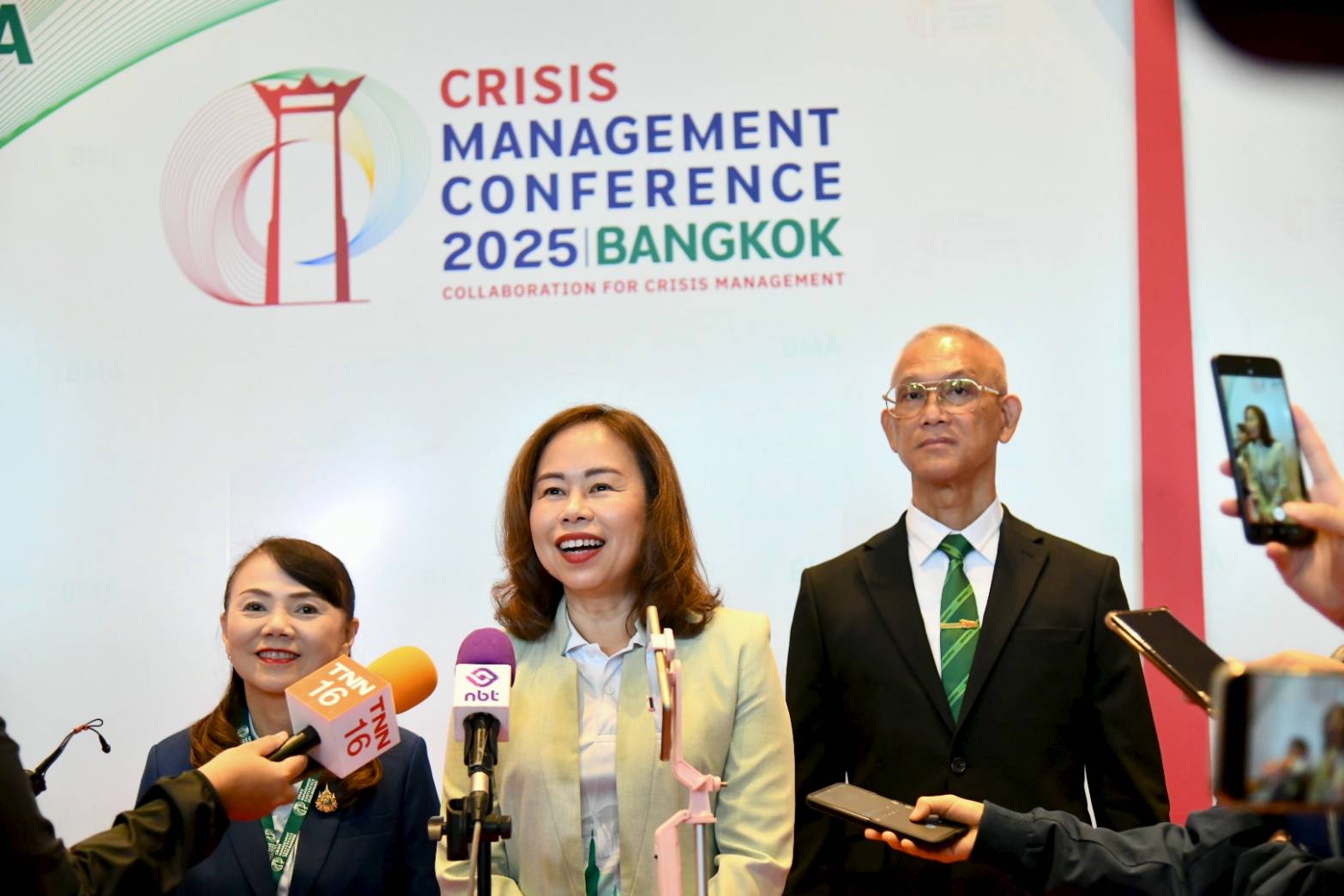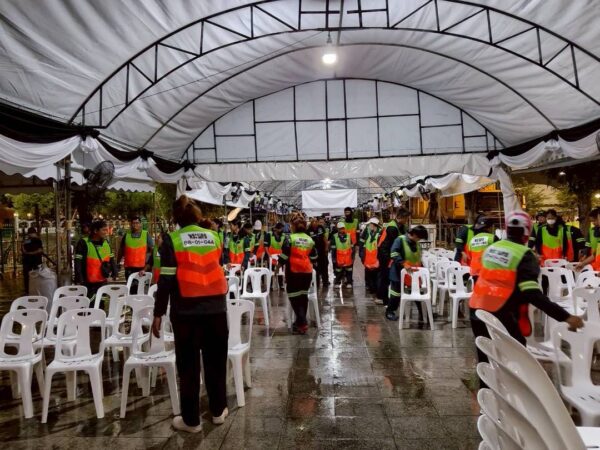
Cities worldwide unite to tackle growing climate threats as conference highlights need for proactive disaster preparedness
(May 22, 2025) —The Crisis Management Conference 2025 concluded in Bangkok on Thursday with delegates from 13 cities worldwide committing to enhanced cooperation in urban disaster preparedness, as climate-related emergencies continue to intensify across the globe.
Hosted by the Bangkok Metropolitan Administration at the Asawin Grand Convention Hotel, the first day of the two-day conference (May 22-23) brought together experts from Delhi, Hanoi, Jakarta, Kuala Lumpur, London, Manila, New Taipei City, Seoul, Singapore, Taipei City, Tokyo, and Ulaanbaatar under the theme “Collaboration for Crisis Management.”
The second day of the conference (May 23) included a field trip visit to study high-rise rescue operations and flood management.
The conference served as a vital platform for sharing innovative strategies and collaborative approaches to urban disaster preparedness, with delegates emphasising the critical importance of integrating cutting-edge technology alongside community-based disaster risk reduction initiatives.
Bangkok Deputy Governor Tavida Kamolvej delivered a compelling keynote address that underscored the urgent need for cities to move beyond reactive emergency responses towards proactive resilience-building strategies.
Drawing on Bangkok’s recent 49-day emergency operation following a major disaster, she highlighted the enormous challenges faced in coordinating urban search and rescue efforts.
“We faced enormous challenges, not only in managing immediate emergencies but also in coordinating urban search and rescue efforts,” Tavida explained. “It’s clear that we need to be better prepared before crises occur, rather than just responding afterwards.”
The Deputy Governor outlined Bangkok’s mounting vulnerabilities, from rising sea levels and extreme weather due to global warming to ageing infrastructure struggling to cope with modern climate realities. She noted that the city now faces “rain bombs” and increased flood risks that existing systems cannot fully withstand, as “our infrastructure was designed for a different climate and urban landscape.”
Tavida proposed innovative solutions, including integrating smart monitoring systems into high-rise buildings. “Instead of selling apartments with free furniture, we could sell them with built-in sensors that monitor structural movement and potential earthquake impacts, helping us protect residents without relocating them unnecessarily,” she suggested.
The Deputy Governor stressed the importance of bridging the gap between academia and practitioners, noting that “different countries have different government systems and educational structures, which can sometimes hinder effective disaster response.” She called for stronger links between research and practice to improve hazard anticipation.
Addressing institutional challenges, Tavida emphasised the need for legal reform and more inclusive procedures, particularly for vulnerable groups. “Our laws and procedures must evolve to ensure equity and rapid response, especially for vulnerable groups like urban poor and the elderly, who make up a significant portion of Bangkok’s population—sometimes as high as one-third in certain districts.”
She also advocated for enhanced regional data sharing, proposing integrated systems across ASEAN and Asia Pacific to “better understand and respond to cross-border hazards, pollution, and climate impacts.”
During panel discussions, Thai experts including Chatchadaporn Boonpreeranat detailed Thailand’s national disaster management system, whilst Thawatchai Palakhamarn highlighted technological innovations such as drone technology and IoT systems that have significantly reduced response times. Duangnapa Uttamangkapong discussed practical challenges in disaster scenarios, emphasising the importance of integrating technology with community-based responses.
The conference highlighted successful international cooperation initiatives, with Singapore’s focus on training and preparedness, Malaysia’s emphasis on community engagement, and Metro Manila’s integrated flood mitigation planning serving as exemplary models. Tokyo’s evolution in CBRN (Chemical, Biological, Radiological and Nuclear) preparedness demonstrated the continuous innovation required in disaster response training.
Key sessions explored innovation for smart cities, climate change adaptation, all-hazard planning, and coordination strategies during crises. The integration of artificial intelligence and underground systems emerged as particularly promising areas for enhancing urban resilience.
The Annual Report from the Crisis Management Network Secretariat outlined the network’s commitment to capacity building through human resource development and knowledge sharing. Now in its 22nd year, the network has facilitated joint exercises with Tokyo’s Fire Department, international urban search and rescue courses by Singapore’s SCDF, and disaster prevention programmes in Taipei.
The network’s emergency hotline, which enables real-time information sharing between member cities, was highlighted as a crucial tool for improving crisis response coordination across borders.
In a significant announcement, the Secretariat revealed that Seoul has been selected to host the 2026 Crisis Management Conference. Kwon Hyuk-min, Head of Seoul’s Fire and Disaster Department, expressed the city’s commitment to advancing disaster response through innovative technology and citizen engagement.
“Recent climate-related disasters underscore the importance of international cooperation, and Seoul aims to contribute to strengthening global resilience,” Kwon stated. Seoul previously hosted the conference in 2005, 2011, and 2017, bringing considerable experience to the role.
Bangkok Governor Chadchart Sittipunt closed the conference with sobering reflections on the inevitability of urban crises. ” I believe the crisis will happen sooner or later. For Bangkok, it may come sooner than we expect,” he said, citing Myanmar’s recent earthquake as a stark reminder of unpredictable disasters.
The Governor recounted a remarkable incident where a 33-storey building in Bangkok collapsed during the Myanmar earthquake, breaking two world records: the greatest distance between an earthquake’s epicentre and a building collapse (1,000 km), and the tallest building to completely fall under seismic activity.
Having spent 48 days on-site during rescue and recovery efforts, Chadchart emphasised that experience remains the most vital asset in crisis situations, alongside technology. He particularly praised the role of drones, describing them as “your third, fourth, fifth, sixth, seventh eyes in the air” for enhancing operational efficiency.
“Experience and technology will be the key thing for future crisis preparation,” he concluded, expressing hope for continued collaboration at the next conference in Seoul.
The conference also featured exhibitions on city vulnerable populations, road safety, and urban flooding, aimed at raising public awareness and promoting practical solutions for safer cities.
As delegates departed Bangkok, the overarching message remained clear: building resilient cities requires sustained international cooperation, technological innovation, and community engagement in the face of increasingly frequent climate-related disasters.




